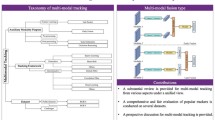Abstract
This paper presents a multiple model real-time tracking technique for video sequences, based on the mean-shift algorithm. The proposed approach incorporates spatial information from several connected regions into the histogram-based representation model of the target, and enables multiple models to be used to represent the same object. The use of several regions to capture the color spatial information into a single combined model, allow us to increase the object tracking efficiency. By using multiple models, we can make the tracking scheme more robust in order to work with sequences with illumination and pose changes. We define a model selection function that takes into account both the similarity of the model with the information present in the image, and the target dynamics. In the tracking experiments presented, our method successfully coped with lighting changes, occlusion, and clutter.




























Similar content being viewed by others
References
Arnaud E, Memin E, Cernuschi-Frias B (2005) Conditional filters for image sequence-based tracking—application to point tracking. IEEE Trans Image Process 14:63–79
Birchfield S, Rangarajan S (2005) Spatiograms versus histograms for region-based tracking. Proc IEEE Conf Comput Vis Pattern Recognit 2:1158–1163
Bradski G (1998) Real time face and object tracking as a component of a perceptual user interface. In: Proceedings of the 4th IEEE workshop applications of computer vision, pp 214–219
Bradski GR (1998) Computer vision face tracking for use in a perceptual user interface. Intel Technol J 2
Collins RT (2003) Mean-shift blob tracking through scale space. IEEE Conf Comput Vis Pattern Recognit 2:234–240
Comaniciu D, Meer P (2002) Mean shift: a robust approach toward feature space analysis. IEEE Trans Pattern Anal Mach Intell 24:603–619
Comaniciu D, Ramesh V, Meer P (2003) Kernel-based object tracking. IEEE Trans Pattern Anal Mach Intell 25:564–577
Deutscher J, Blake A et al (1999) Tracking through singularities and discontinuities by random sampling. In: Proceedings of international conference on computer vision, vol 2, pp 1144–1149
Felzenszwalb P, Huttenlocher D (2000) Efficient matching of pictorial structures. Proc IEEE Conf Comput Vis Pattern Recognit 2:66–73
Fleuret F, Berclaz J et al (2008) Multicamera people tracking with a probabilistic occupancy map. IEEE Trans Pattern Anal Mach Intell 30:267–282
Gualdi G, Albarelli A et al (2008) Using dominant sets for object tracking with freely moving camera. In: Proceedings of the 8th international workshop on visual surveillance
Isard M, Blake A (1998) Condensation—conditional density propagation for visual tracking. Int J Comput Vis 29:5–28
Kailath T (1967) The divergence and Bhatacharyya distance measures in signal selection. IEEE Trans Commun Technol 15:52–60
Kalman RE (1960) A new approach to linear filtering and prediction problems. Trans ASME—J Basic Eng 82:35–45
Liu TL, Chen HT (2004) Real-time tracking using trust-region methods. IEEE Trans Pattern Anal Mach Intell 26:397–402
Lucena M, Fuertes JM, Perez de la Blanca N (2005) Real-time tracking using multiple target models. Lect Notes Comput Sci 3522:20–27
Maggio E, Piccardo E et al (2007) Particle PHD filter for multi-target visual tracking. In: Proc. of IEEE international conference on acoustics, speech and signal processing (ICASSP 2007)
Moeslund T, Hilton A, Krüger V (2006) A survey of advances in vision-based human motion capture and analysis. Comput Vis Image Underst 104:90–126
Peng NS, Yang J, Zhou DK (2006) Study on Bhattacharyya coefficients within mean-shift framework and its application. Soft Comput 10:1127–1134
Porikli F, Tuzel O (2003) Human body tracking by adaptive background models and mean-shift analysis. Mitsubishi Electric Research Laboratories
Ramanan D, Forsyth D, Zisserman A (2007) Tracking people by learning their appearance. IEEE Trans Pattern Anal Mach Intell 29:65–81
Salinas R, García-Silvente M, Medina Carnicer R (2008) Adaptive multi-modal stereo people tracking without background modelling. J Vis Comun Image Represent 19:75–91
Shen C, Brooks M, Hengel A (2007) Fast global kernel density mode seeking: applications to localization and tracking. IEEE Trans Image Process 16:1457–1469
Sullivan J, Blake A et al (2001) Bayesian object localisation in images. Int J Comput Vis 44:111–135
Yang M, Wu Y, Hua G (2009) Context-aware visual tracking. IEEE Trans Pattern Anal Mach Intell 31:1195–1209
Yilmaz A, Javed O, Shah M (2006) Object tracking: a survey. ACM Comput Surv 38:13
Zhao Q, Tao H (2005) Object tracking using color correlogram. Proc IEEE Conf Comput Vis Pattern Recognit, pp 263–270
Zhou SK, Chellappa R, Moghaddam B (2004) Visual tracking and recognition using appearance-adaptive models in particle filters. IEEE Trans Image Process 13:1491–1506
Acknowledgements
This work has been financed by Grant TIC-2001-3316 and TIC-2005-1665 from the Spanish Ministry of Science and Technology.
Author information
Authors and Affiliations
Corresponding author
Rights and permissions
About this article
Cite this article
Lucena, M., Fuertes, J.M., Pérez de la Blanca, N. et al. Tracking people in video sequences using multiple models. Multimed Tools Appl 49, 371–403 (2010). https://doi.org/10.1007/s11042-009-0376-7
Published:
Issue Date:
DOI: https://doi.org/10.1007/s11042-009-0376-7




